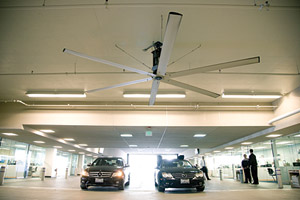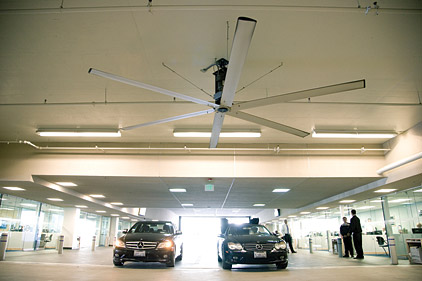
|
| A MacroAir AirVolution fan provides circulation and energy savings at a Beverly Hills, Calif., Mercedes Benz dealership. The fan’s use of six blades, rather than 10 blades, helps reduce energy use by 40 percent. |
The Centers for Disease Control and Prevention (CDC) estimates that the majority of Americans spend 90 percent of their time indoors. On average, office workers spend approximately 40 hours each week in office buildings. These workers also study, eat, and drink in enclosed environments where make-up air, or fresh air added to recirculated air, may be compromised. In fact, some experts believe that more people may suffer from the effects of indoor air pollution than outdoor air pollution.
Indoor environmental quality, as the name implies, refers to the quality of air inside a building environment. Indoor environments are highly complex and occupants may be exposed to a variety of contaminants in the form of gases and particles from machines, cleaning products, construction activities, carpets, furnishings, perfumes, smoke, microbial growth, insects, outdoor pollutants, and more. Other factors such as indoor temperatures, relative humidity, and ventilation levels impact how individuals respond to indoor environments.
Who You Gonna Call?
More and more HVACR contractors have taken on the role as indoor air pollution problem solvers. By preventing, controlling, and resolving indoor environmental issues, technicians are providing customers with a cleaner, healthier indoor environment; and, in turn, contractors are inheriting increased profit margins.
“About 80 percent of our clients are interested in going over options that provide cleaner, fresher, healthier air. We sell around $80,000 a month,” said Brian Leech, owner, Service Legends, Des Moines, Iowa. “We stress that these products reduce breakdowns and extend the life of the system. We’ll then pull samples from a clogged or underperforming system and ask customers if they want to leave this stuff in or do what it takes to get it out.”
Russ Donnici, president, Mechanical Air Service Inc., San Jose, Calif., said the key to selling indoor environmental products is educating the consumer. To share this knowledge, Donnici, since 1992, has staffed a full-time registered California Environmental Protection Agency (EPA) environmental assessor. The individual’s goal is to help keep customers and the company up-to-date on the latest IAQ trends, products, and solutions.
“We’ve found that if consumers are made aware of what is available to them, they are willing to spend an extra buck for a cleaner and healthier environment,” he said. “These products not only improve indoor air quality, but help keep HVAC systems operating at peak efficiency.”
Donnici said identifying problem areas, and offering solutions at varying prices, is a key step to closing a sale.
“We use MERV 11 pleated filters on standard units. On new systems and upgrades we also always offer UV lighting systems, specifically the Ultravation dual-bulb UV light system,” he said. “We also quote an Aprilaire media filter and an electronic air cleaner. Typically the media filter is selected 35 percent of the time, the electronic air cleaner is selected 50 percent of the time, and the UV light systems are chosen 70 percent of the time.”
Technicians at Bay Area Air Conditioning, Crystal River, Fla., have had great success selling indoor air quality products, but admit IAQ improvements aren’t always what customers are looking for when they call.
“Usually the leads that come into our office for IAQ products are not a straight-forward, ‘how much are UV lights or filters,’” said Jolene Methvin, system designer and estimator. “What we usually hear is ‘why is my house so dusty,’ or ‘I can’t live with this musty smell anymore.’ The homeowner will call and will more often than not be unaware of the available IAQ solutions.”
Methvin said the company has had the most luck moving air purifiers, media filters, and UV lights.
“Homeowners who buy air purifiers are usually specifically looking for them because they’ve already done their research. These customers typically have special medical needs and have decided they need a purifier before they ever pick up the phone,” she said. “Although there are less expensive, throw-away, or washable filters available, more homeowners are choosing to go with media filters based on convenience and the fact that it doesn’t need to be changed or cleaned as often.”
Jim Cosmas, general manager, The Weather Busters, New York, suggested technicians should consider offering duct sealing services when addressing IAQ at the kitchen table.
“Dirty ducts are an easy thing to address, but duct sealing is rarely discussed. Aside from efficiency and capacity loss, leaking ductwork, particularly on the return side of the system, will bring in air from areas that are usually not being conditioned,” he said.
“Systems in attics and unfinished basements that have leaking return air ducts are drawing in air from hot attics and musty basements and distributing that air throughout the living space. Seal these ducts, and the problem goes away.”
Sidebar: Helpful Links
Here is a list of websites with helpful information on Indoor Environmental Quality:
• U.S. General Services Administration’s Indoor Environmental Quality — http://bit.ly/MSqyww
• Centers for Disease Control and Prevention — http://1.usa.gov/KKDQwn
• National Institute of Building Sciences’ Whole Building Design Guide — http://bit.ly/NxlACT
• Environmental Energies Technologies Division — http://1.usa.gov/Lzvffn
• Indoor Air Health Advisor — http://bit.ly/Or1oIQ
• Lawrence Berkeley National Laboratories — http://bit.ly/MSqIE7
• Educational Information and Resource Center — http://bit.ly/KZOVuS
Publication date: 7/16/2012



Report Abusive Comment